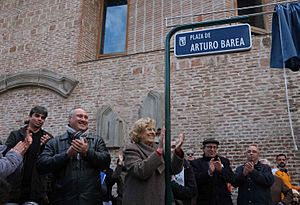Arturo Barea facts for kids
Quick facts for kids
Arturo Barea
|
|
|---|---|
 |
|
| Born |
Arturo Barea Ogazón
20 September 1897 Badajoz, Spain
|
| Died | 24 December 1957 (aged 60) Faringdon, Oxfordshire, England
|
| Resting place | All Saints Church, Faringdon |
| Nationality | Spanish |
| Citizenship | Spain United Kingdom (from 1948) |
| Occupation | Writer, journalist, broadcaster |
| Spouse(s) | Aurelia Rimaldos (1924-1937) Ilse Pollak (1938-1957) (his death) |
Arturo Barea Ogazón (born September 20, 1897 – died December 24, 1957) was a Spanish journalist, radio speaker, and writer. After the Spanish Civil War, Barea and his wife, Ilsa Barea, moved to live in England. He passed away there.
Contents
Biography
Early Life and Challenges
Arturo Barea was born in Badajoz, Spain. His family was not wealthy. His father died when Arturo was only four months old. His mother had four young children to care for. She worked as a laundress, washing clothes in the Manzanares River. The family lived in a small attic room in the poor Lavapiés area of Madrid.
Arturo was partly raised by his aunt and uncle. They had enough money to send him to school. This showed him the big differences between social classes in Spain. His own sister once accused him of "acting like a gentleman" while she worked as a servant. When he was 13, he left school. He got a job at a bank as an office boy. He copied documents by hand. He later quit after being fined for breaking a glass desk cover.
Military Service and Early Career
Barea had to do his military service in Ceuta and Morocco. He joined the army again as a regular soldier. He became a sergeant in an Engineers regiment. He fought in the Rif War, a conflict in North Africa. During this time, he started writing poems.
After the army, he worked in an office that registered patents. He had always wanted to be an engineer. In 1924, he got married for the first time. He was a member of a socialist workers' union called UGT (Unión General de Trabajadores). In 1931, he helped start the Clerical Workers Union. This was at the beginning of the Second Spanish Republic.
The Spanish Civil War
When the Spanish Civil War began in 1936, Arturo Barea helped organize a volunteer group. It was called La Pluma (The Pen). It was made up of office workers fighting with the UGT. Later, because he knew English and French, he worked as a censor. He worked at the Foreign Ministry's Press Office. There, he met famous writers like Ernest Hemingway. He also met many foreign journalists who were reporting on the war.
During the Siege of Madrid, he joined the Radio Service. He broadcasted to Latin America. He became known as An Unknown Voice of Madrid. Every night, he shared stories about daily life in the city under attack. He also met an Austrian journalist named Ilse Kulcsar. They got married in 1938.
Life in Exile
As the Spanish government faced defeat, Barea had to leave Spain. He also had some difficulties with the Communist party and his health was poor. So, he and his wife went to France in 1938. Then, they moved to England in 1939.
From then until he died, Barea worked for the BBC's World Service Spanish section. He also wrote articles and reviews for different magazines. He also wrote many books. His wife, Ilsa Barea, also worked for the BBC. She translated books into English and gave talks in several languages.
Arturo Barea spent his last ten years living in a house called Middle Lodge in Eaton Hastings. This house was rented from Gavin Henderson, 2nd Baron Faringdon, a lord who lived nearby.
He passed away on December 24, 1957, from a heart attack. His ashes were scattered in his garden at Middle Lodge. A memorial for Barea and his wife was placed near her parents' grave in the churchyard of All Saints Church in Faringdon, Oxfordshire. Ilsa Barea later returned to Vienna. She died there while writing her life story.
Today, three streets in Spain are named after Arturo Barea. They are in Badajoz, Mérida, and Novés. There is also a square, Plaza de Arturo Barea, in Madrid. He is also an important character in the book Hotel Florida by Amanda Vaill, published in 2014.
See also
 In Spanish: Arturo Barea para niños
In Spanish: Arturo Barea para niños


